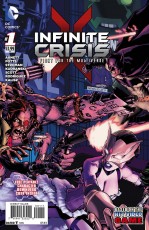Like Injustice: Gods Among Us before it, Fight For The Multiverse is a comic book based on a video game based on a comic book. For DC comics die-hards, there’s a lot of familiar territory to be covered, but how good is the actual execution? Your Major Spoilers review of Infinite Crisis: Fight For The Multiverse #1 awaits!
 INFINITE CRISIS – FIGHT FOR THE MULTIVERSE #1
INFINITE CRISIS – FIGHT FOR THE MULTIVERSE #1
Writer: Dan Abnett
Layouts: Carl Potts
Penciler: Larry Stroman/Szymon Kudranksi
Inker: Trevor Scott
Colorist: Alejandro Sanchez Rodriguez/John Kalisz
Letterer: Wes Abbott
Publisher: DC Comics
Cover Price: $3.99
Previously in Infinite Crisis – Fight For The Multiverse: From the earliest Silver Age adventures of the heroes of DC Comics, the multiverse played a crucial role in establishing setting and tone. Nostalgia for the past came in the heroes of Earth-2, while the idea of heroes-as-villains arrived early with the reverse-world of Earth-3. As DC Comics engulfed their competitors, the heroes of Quality, Fawcett and Charlton Comics made the scene, each with their own alternate Earth, until the massive crossover madness of ‘Crisis On Infinite Earths’ set the precedent that even the multiverse could have alternate versions. These days, DC’s usual party line is that there are 52 alternate worlds, all vibrating in similar-but-different harmony, and each contains a cast similar to but different in key ways from the heroes that we already know…
A VERY ’90S’ TAKE
We open our festivities this issue with some flashback action, an explanation of the concepts of the Multiverse, and how it came to be that the infinite earths were whittled down to fifty-two worlds. Amazingly, this issue explains the events of the original Crisis On Infinite Earths, right down to the death of Supergirl in the arms of her grieving cousin, a moment that I was certain had been declared no longer in continuity, but one that I’m glad to see anyway. That serves as one of several cues to let the reader know that what we’re about to see isn’t in regular DCU New 52 canon, a nice touch on behalf of Lanning and the creative team, and one that helps me to set this series into its own continuity channels. We are introduced to the world of The Monitors, just in time for them to be wiped out, leaving Monitor Nix Uotan as the only survivor. Uotan sends out his agent, Harbinger (wearing a shoulder-pads-and-belts combo that feels straight out of a 1993 issue of ‘Youngblood’) to scan the multiverse and gather a force to help him offset the coming Infinite Crisis. We get little pieces of various worlds on her journey, including the steampunk world of ‘Gotham By Gaslight’, a variant where atomic war has mutated everyone, and even a strange world where it seems the Thanagarians have successfully captured and colonized our world.
THE DIGITAL-FIRST MODEL IN ACTION
There’s a rather abrupt art-shift in the middle of this issue, as the bound version of the book actually contains TWO issues of the digital-first IC:FFTM comic, and it’s something of a jarring change, moving from a noodly McFarlane/Larsen work to a darker, more subtle look evocative of the art of Tony Harris. I have to say, I like the second half better, as it puts us squarely in Gotham City and follows our POV character (Batman, natch) as he encounters Harbinger for the first time. There’s some lovely moments in the second half of the book, including Batman being WRONG (he thought that he was tracking Catwoman, but Harbinger was actually luring him in) and a moment where even the Dark Knight is taken aback at being teleported through the Bleed to Earth-19, Gotham By Gaslight. There are awkward moments (notably the fact that they keep calling Earth-19 ‘The Gaslight World’), and much of what we see will be familiar to those who have read the previous Crisis comic-book crossovers. Dan Abnett does well in keeping things grounded, and while the art styles aren’t equally pleasing to my eye, neither team delivers anything truly unpleasant to look at in these pages.
THE BOTTOM LINE: AN OKAY START
As someone who really disliked the central premise of the previous video game adaptation (the thought process of ‘What would it take to make Superman a totally awesome killer guy?’ chafed me hard), I’m happy to say that this book is okay, with an interesting premise to play with. Seeing the alternate characters on this cover (Atomic Two-Face especially) makes it clear that there are things we HAVEN’T seen before, but the creators are skilled enough to make it clear that we’re not going to be totally off the rails. I might have preferred a different central character (Batman, for all his versatility, seems like he might be less useful in radioactive wastelands or strange territories than, say, Superman or Booster Gold), but all in all, this book delivers on its premise. Infinite Crisis – Fight For The Multiverse #1 is a solid book, even for those of us who don’t intend to play the video game, and uses the existing lore of the DCU to build a foundation for what could be a good solid world-hopping adventure tale, earning 3 out of 5 stars overall.



